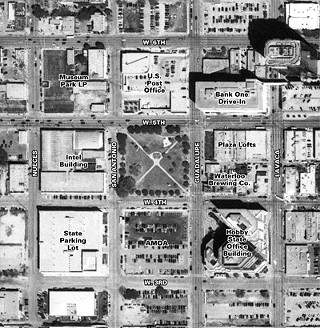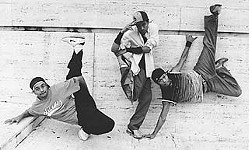Vision of a New Republic
Plans for Republic Square Emphasize Art, People, and Commerce
By Chale Nafus, Fri., July 13, 2001
![Can Republic Square (seen here from the northeast) become a beautiful public gathering place that attract[s] a variety of citizens with cultural (dance, music, arts), political, civic, historic, outdoor film, and family-oriented programs?](/imager/b/newfeature/82359/fbeb45bb/pols_feature-10569.jpeg)
When Bobbie Barker, regional vice-president of Southern Union Gas, was chair of the Downtown Austin Alliance in 1997-98, she was determined to focus attention on the historic downtown parks (Republic Square, Wooldridge Park, and Brush Square). "That's when we began the process of surveying the parks, identifying the stakeholders around each of the parks, and working with the Austin Parks and Recreation Department to give some attention to those parks. It really fit in nicely with the mayor and City Council's attention on downtown. Downtown has been characterized as the living room of the city of Austin, and we looked at these downtown parks as the front yard of that living room."
Then, as it became apparent that Computer Sciences Corp., the new City Hall, the Austin Museum of Art, and new residential units would all arise in the vicinity of Republic Square, the DAA's attention focused on the southwest quadrant of downtown.
In 1999, at the direction of the City Council, the DAA and the Austin Parks and Recreation Dept. formed a Republic Square Task Force of neighboring business owners, residents, and members of the arts community, who were soon joined by the Austin Parks Foundation. Recommendations were drawn up to determine the use of the park and its appearance, secure capital improvements, program the park with special events, and link it with surrounding properties and other downtown spaces. Landscape architects sketched out designs for improvements to the park, but the ideas lay dormant for about a year.
By the fall of 2000, the Austin Museum of Art finally owned the land at Fourth and Guada-lupe, directly south of the square, on which it had originally wanted to build. And Republic Square became a hot topic once again. In December, Ginny Sanders was hired by the Austin Parks Foundation and the DAA to serve as project manager over downtown historical parks. She facilitated meetings of history buffs, art and music supporters, restaurant owners, residential development reps, property owners, city staff, and members of APF and DAA to review the previous recommendations and to determine "what we are still interested in doing, and move forward with the planning, the programming, and the fundraising."

The result was a memorandum of understanding, signed in February 2001 by the Austin Parks Foundation, DAA, and city of Austin Parks & Recreation Dept., which formalized their partnership in revitalizing the "downtown historic parks, beginning with Republic Square, creating beautiful public gathering places that attract a variety of citizens with cultural (dance, music, arts), political, civic, historic, outdoor film, and family-oriented programs."
Accessible, Visible, Sociable
To bring heightened awareness to Republic Square and its possibilities, on May 15 the partnership held a picnic in the park. Guest speaker was Fred Kent, founder and president of the New York-based Project for Public Spaces, who is consulting on the design of the park. An eloquent visionary of the creative use of parks, squares, and plazas, Kent believes that "no development adds more to a city than a great public space." He proposed numerous principles for creating such a public space in Republic Square.
Kent believes that a park is about soul, heart, and use, not just a clever design. The park should be accessible, visible, and sociable, and Kent recommends experimenting with the design over time -- testing, evaluating, and modifying the design as use of the space evolves. Different groups will find various reasons to use the park at different times, and planners should find ways to encourage that diversity. Form supports function -- the functions that come to take place in Republic Square should determine the form and design of the park as it evolves.
Mirroring many of Kent's ideas as well as proposing their own, the task force issued a request for proposals this past spring, to elicit ideas from area landscape architects for redesigning the park. The RFP reveals the planners' thinking about the space and its uses: "We anticipate enhancing the landscape to provide color, providing space for food kiosks, providing moveable seating and tables, upgrading electricity, enhancing lighting, providing a water source for large events, removing berms or creating terraced seating on berms, replacing/repairing sidewalks, improving security, providing an information kiosk and amenities for dog walks, preserving the historical Auction Oaks, providing shade, and determining placement of a performance stage." Also under the terms of the RFP, the winning architectural consultants must coordinate their design with Fred Kent and Jesús Bautista Moroles, the artist commissioned to design the park's performance stage.
Ginny Sanders promises, "We are going to make sure that every local architect in Austin has a chance to submit something." Twelve proposals have already been received, and more are expected, with a decision on the contract award expected sometime later this year.
Music, Art, Vegetables
Republic Square is already blessed with a lot of pleasant trees, including the Auction Oaks from 1839 (or the descendants of those trees under which Edwin Waller sold the original Austin lots at public auction), and 15- to 20-year-old cypresses planted during a previous revitalization effort (see "A Brief History," below). Early discussions suggest that the artificial berms must go, except for the northern one, which somewhat camouflages the starkness of the post office design across the street. Some of the benches on the outer edge of the square should be turned inward toward the park, and additional seating should join the benches already inside the park. And, should residential development downtown continue, in time a playground is a possibility.

The park already has a fountain (reactivated in 1999 after a 10-year silence), but there is talk of a new design incorporating a waterwall or a more impressive fountain. With the Town Lake hike and bike trail just four blocks away, direct, safe access from Republic Square would be ideal. Andy Hinman, an architect with BarbeePratte Associates, points out that actual park use should determine variations in the space. "There may be some places where people move in from a lot of activity to less activity. There may be some places for a cluster of trees and some tables where it's perfectly appropriate for two people playing chess and two people watching them. You want to define the spaces in a square in a way that makes it comfortable for those kinds of thing to occur. If you just have a big, undefined, gridded space with interesting sculpture, it doesn't happen."
Indeed, the site's proximity to the Austin Museum of Art could create a number of performance opportunities: indoor and outdoor music, film, art, and lectures. The Art and Technology Gallery of AMOA will contain some exhibits that can be seen from the park. There is also the possibility of back-projecting images, moving or still, onto parts of the museum's upstairs glass walls. Time Warner is talking with the task force about replicating their Bryant Park (NYC) films in the park. The Austin Film Society, Austin Cinemaker Co-op, Cine Las Americas, and ReelWomen would probably entertain the idea of showing films in the park, as well as in the 300-seat theatre planned for the museum.
Community organizations could hold events in the square, including regular markets for fresh produce, books, stamps, and birds. Music would always be welcome, if not on the scale of concerts at Auditorium Shores or in Waterloo Park. With an emphasis on smaller arts and culturally focused events, Republic Square could become downtown Austin's preeminent outdoor cultural activity center. Judith Sims, director of the AMOA Art School, sees the possibility of Republic Square becoming like public plazas in Guanajuato and other parts of Mexico, where music and dance complement people-watching, conversing, and snacking.
In fact, the park is already getting used more. AMOA moved its Fine Arts Festival (formerly Fiesta) there last year, Waterloo Brewing Company sponsored a beer-tasting event in May, and other groups are talking to the task force about holding events, including yoga classes in the fall, and a jazz concert and Italian Renaissance performances by the Austin Commedia Society.
But to expand any significant use of the park, many infrastructure improvements are needed. Jacqui Schraad of AMOA's Fine Arts Festival says, "Right now, it's so expensive to do any events there." The festival must provide its own electricity, water, tents, and stage. "We are trying to make it more hospitable than that." Besides securing the basic amenities, the task force wants to secure a performance area -- something more than a raised platform with some lights.

To that end, the Texas Commission on the Arts is currently negotiating a $250,000 contract with world-renowned sculptor Jesús Bautista Moroles, commissioned to design the park's performance space. If the deal is completed, Bautista Moroles would design an amphitheater, on the south side of the park directly across the street from the museum -- perhaps similar to the one he built several years ago at his Cerrillos Cultural Center, south of Santa Fe (see his Web site at www.moroles.com). That beautiful stone structure is modeled on a Pueblo kiva.
Currently Bautista Moroles is designing performance spaces for public parks in China. Bobbie Barker says the sculptor "wants to make sure his artwork is something touchable and usable," and "that it can perhaps even be modified or adjusted as use becomes more obvious." That aesthetic sensibility is certainly in keeping with Fred Kent's ideas of revitalization coming in phases, determined by evolving uses of a space. Current plans are for the work to be finished in 2004, concurrent with the art museum (see "The Art of Saving AMOA," p.28).
Good Squares Make Good Neighbors
The final location of the new museum was doubtless the principal catalyst for this push to revitalize Republic Square. AMOA Education Director Eva Buttacavoli says, "I feel it's very important that the Museum plays an active role in the revitalization of Republic Square because it will be, in essence, our front yard, but also for the future of the development of the downtown area as a more family-oriented and/or pedestrian-friendly space."
The architects for the downtown museum, Gluckman Mayner of New York, obviously acknowledged the presence of Republic Square in their designs. The museum will face north, toward the park, with the building façade and plaza conceived as a "front porch, something that would be very welcoming," says Judith Sims. Republic Square and the museum plaza will complement each other with a water sculpture, structural overhang, outdoor seating for a cafe, and varying degrees of transparency built into the front walls of the building, while the park will provide vistas of trees, bushes, flowers, grass, and activities.
To bring attention to the proposed location for the new museum in 2000, the AMOA Guild moved its annual Fine Arts Festival from the museum grounds at Laguna Gloria to the area around Republic Square. Jacqui Schraad, Guild director and now events coordinator for the Republic Square task force, credits the move with greater visibility for the arts. "Fiesta was very successful at Laguna Gloria, but it was sort of a little private West Austin event. Downtown so many people said they had never heard of the festival. We had walk-ins downtown. We have doubled our audience." The downtown festival also increased awareness of Republic Square, and planners hope that the new museum and revitalized park will generate additional interest in the neighborhood.

Less encouraging is the eyesore of the unfinished Intel building to the west. Despite the suspended construction, Bobbie Barker says that Intel remains a good neighbor. "They are looking to see what they can do to help support some of the development at Republic Square," Barker said, "so they are still an active participant in the development." Andy Hinman directs attention to the large open space in the L-shaped building, which suggests the Intel architects considered the park in their design, connecting its green space to the probable trees and plants of their courtyard. Fred Kent suggested as a temporary solution that the corporation cover its park side with a "scrim looking like the future building."
To the north of the square is what Kent calls the "worst design in the world to face Republic Square," the poured concrete and almost featureless U.S. Post Office. Hinman calls the building "an abomination" and suggests covering the street-level walls with vines or murals or even a waterwall, which could complement the water displays planned for the park and the museum. If the Hobby Building reactivates its fountains, the area could be bursting with water sculptures. Ginny Sanders discovered that the U.S. Postal Service has a Good Neighbor program that has funded projects in other cities, but the downtown manager told her there is now a spending freeze. However, Sanders said, postal employees are "interested and open to learning any other ways they might be able to help."
East of Republic Square will be the Plaza Lofts, currently under construction. Owner-developer Mac Pike, president of Sutton Properties and member of the RSTF, says that the majority of the units as well as a planned first-floor restaurant will face the park, which is "very much a focus of all of our efforts." Hinman believes the Lofts building will be a good neighbor, helping to define the outer "wall" of the park and providing additional safety for park users, who could be seen from windows and balconies.
The other business to the east is Waterloo Brewing Company. Owner Billy Forrester, who is working with the task force, calls the park revitalization the "greatest thing to hit downtown. We have this wonderful little park here that has been kind of neglected. With the increase in people living down here, it will become more and more a focal point. And it's important to integrate it with our new art museum."
Everybody's Interests
"Of course, the contiguous partners have the greatest vested interest in redevelopment of the park," says Bobbie Barker. "Downtown business owners and folks who live downtown in general, however, also have a vested interest in redevelopment of the park, so we are going to be looking for partnerships not only from the contiguous property owners, but also from folks downtown in general who recognize the value of having strong squares and hope they will participate with us." She says that "having a strong downtown is truly a win-win proposition. In our community it's so important to leave as much green space as possible open, but it is a given that the downtown area will have a majority of impervious cover. Really focusing on making downtown strong can help leave more outlying areas with green space and keep a really strong tax base downtown. That tax base ultimately goes to finance the roads, the parks, the libraries, police force, and so on throughout the rest of the community. So, our investments in downtown are going to have an incredible return to the community overall."
Property values around Republic Square have indeed gone up dramatically in recent years, as they have throughout the city. This year's appraisals indicate one-year increases from 142% (Waterloo Brewing) to 250% (AMOA). Since 1998, the total appraised market value of the immediate neighborhood has increased 233%, from $13,295,000 to more than $44 million. Such increases definitely add to the city income from downtown property.
Funding is always a thorny question, but Ginny Sanders is confident the park project has sufficient support to proceed. "We have received a donation of $20,000 from Southern Union Gas to the downtown historic parks," Sanders said. "Texas Commission on the Arts has committed $250,000 to the creation of the performance stage, and DAA has money reserved for the parks. With all the interest in Republic Square, we feel confident about fundraising for the parks, and we also hope to receive some pro bono or in-kind services" (for more on funding issues and the AMOA, see "The Art of Saving AMOA," p.28).
While these economic considerations are inescapable, the project's larger civic potential is succinctly suggested by the request for proposals issued a few months ago. "It is envisioned that Republic Square, while retaining its historic value, will be the city plaza of downtown Austin. Its location within a rapidly growing, vibrant, metropolitan setting creates a rich environment for the creation of a civic square with a unique appeal and personality." ![]()
Got something to say on the subject? Send a letter to the editor.








